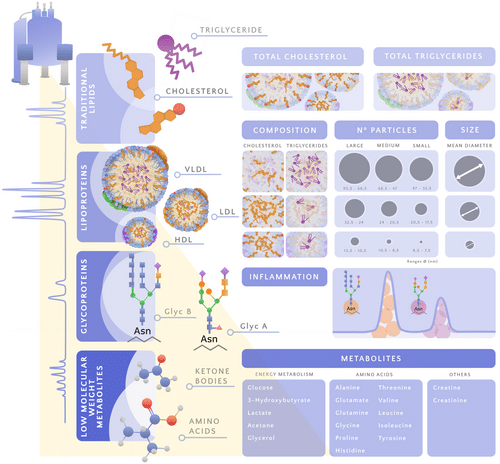Unveiling the Mysteries of Lipoprotein Complexity in Type 2 Diabetes and Cardiovascular Risk
Recent findings published in the European Journal of Clinical Investigation by Montse Guardiola (1 2 3), Pere Rehues (1 2 3), Núria Amigó (2 3 4 5), Francisco Arrieta (6), Manuel Botana (7), José A Gimeno-Orna (8), Josefa Girona (1 2 3), José Ignacio Martínez-Montoro (9 10), Emilio Ortega (11 12 13), Antonio Pérez-Pérez (3 14), Víctor Sánchez-Margalet (15), Juan Pedro-Botet (16 17), and Josep Ribalta (1 2 3) offer new insights into the complex relationship between type 2 diabetes (T2DM) and cardiovascular disease (CVD), specifically through the intricate role of lipoproteins. This comprehensive narrative review sheds light on why individuals with diabetes face high cardiovascular risks, even when their LDL cholesterol levels are controlled or within therapeutic targets.
Lipoproteins, which transport cholesterol through the bloodstream, can cause the silent buildup of cholesterol in the arteries. This condition is not detected by standard cholesterol tests. The study highlights the need to better understand lipoprotein behavior, beyond just measuring cholesterol levels, to better manage and mitigate cardiovascular risks in diabetes.
Researchers propose a three-tiered approach to lipoprotein analysis:
- Routine clinical biochemistry that measures basic lipids.
- Advanced lipoprotein profiling using nuclear magnetic resonance (NMR), which analyzes lipoprotein particles in detail.
- Investigation of minor components and physical properties of lipoproteins that could influence cholesterol accumulation in arteries.
The review indicates that despite reaching LDL cholesterol targets, many individuals still have high rates of cardiovascular events. This is due to atherogenic dyslipidemia, a condition characterized by high levels of triglycerides, remnant cholesterol, and small, dense LDL particles, along with low levels of HDL cholesterol. These factors are not typically addressed with standard cholesterol-lowering therapies.
These findings suggest a more detailed approach to evaluating and managing cardiovascular risk in patients with type 2 diabetes. They recommend advanced lipoprotein testing to uncover risks not revealed by conventional tests. A detailed lipoprotein profile could lead to targeted therapies that address lipid abnormalities, reducing residual cardiovascular risk.
This innovative review urges the integration of these lipoprotein analyses into future research and clinical practice, potentially transforming the evaluation and management of cardiovascular risk in patients with type 2 diabetes.

Affiliations:
- Departament de Medicina i Cirurgia, Unitat de Recerca en Lípids i Arteriosclerosi (URLA), Universitat Rovira i Virgili, Reus, Spain.
- Institut d’Investigació Sanitària Pere Virgili (IISPV), Reus, Spain.
- Centro de Investigación Biomédica en Red de Diabetes y Enfermedades Metabólicas Asociadas (CIBERDEM), Instituto de Salud Carlos III (ISCIII), Madrid, Spain.
- Departament de Ciències Mèdiques Bàsiques, Universitat Rovira i Virgili, Reus, Spain.
- Biosfer Teslab, Reus, Spain.
- Department of Endocrinology, Hospital Ramón y Cajal, Madrid, Spain.
- Departamento de Endocrinología y Nutrición, Hospital Universitario Lucus Augusti, Lugo, Spain.
- Endocrinology and Nutrition Department, Hospital Clínico Universitario Lozano Blesa, Zaragoza, Spain.
- Department of Endocrinology and Nutrition, Virgen de la Victoria University Hospital, Málaga, Spain.
- Instituto de Investigación Biomédica de Málaga (IBIMA)-Plataforma Bionand, Málaga, Spain.
- Department of Endocrinology and Nutrition, Hospital Clínic, Barcelona, Spain.
- Centro de Investigación Biomédica en Red de la Fisiopatología de la Obesidad y Nutrición (CIBEROBN), Instituto de Salud Carlos III (ISCIII), Madrid, Spain.
- Institut d’Investigacions Biomèdiques August Pi Sunyer (IDIBAPS), Barcelona, Spain.
- Servicio de Endocrinología y Nutrición, Hospital de la Santa Creu i Sant Pau, Universitat Autònoma de Barcelona, Barcelona, Spain.
- Department of Medical Biochemistry and Molecular Biology, School of Medicine, Virgen Macarena University Hospital, University of Seville, Seville, Spain.
- Unidad de Lípidos y Riesgo Vascular, Department of Endocrinology and Nutrition, Hospital del Mar, Barcelona, Spain.
- Department of Medicine, Universitat Autónoma de Barcelona, Barcelona, Spain.